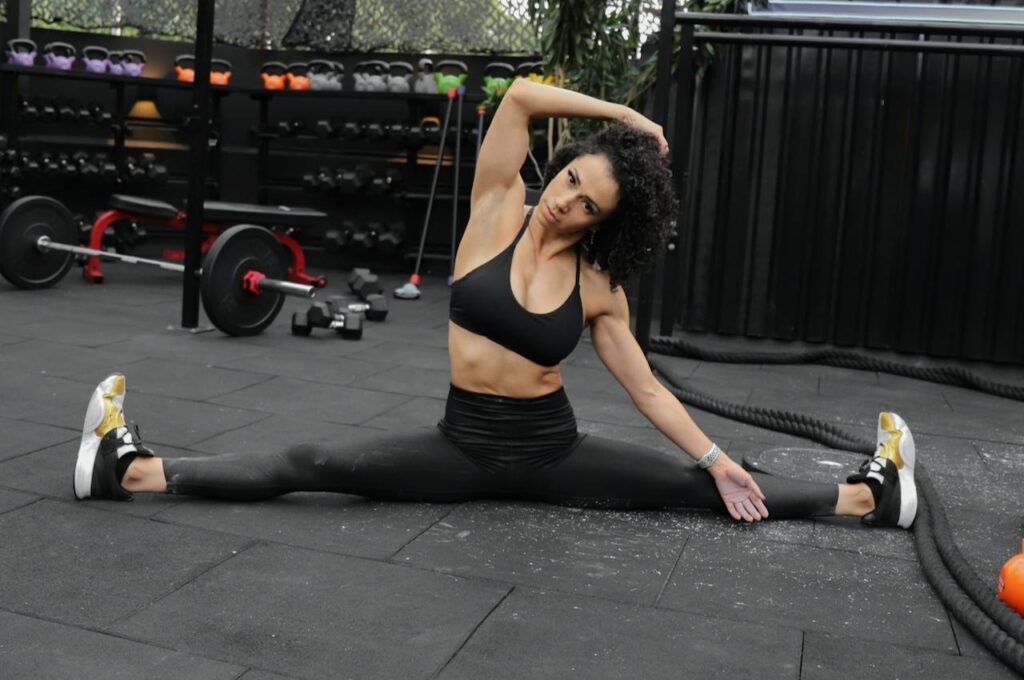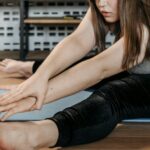Hip external rotation mobility is a critical component of functional movement that affects everything from your daily activities to athletic performance. Whether you’re dealing with tight hips from prolonged sitting, recovering from an injury, or looking to enhance your movement quality, improving your hip external rotation can significantly impact your overall mobility and reduce pain.
This comprehensive guide will walk you through evidence-based exercises, stretches, and programming strategies to optimize your hip external rotation mobility while addressing common limitations and providing solutions for different populations and activity levels.
Understanding Hip External Rotation Anatomy
Hip external rotation involves turning your thigh bone (femur) outward, away from the midline of your body. This movement is controlled by several key muscle groups working together:
Primary Hip External Rotators:
- Piriformis: Often the most discussed hip external rotator, located deep in the buttock
- Gemellus superior and inferior: Small muscles that assist in external rotation
- Obturator internus and externus: Deep muscles that provide stability and rotation
- Quadratus femoris: A square-shaped muscle that contributes to external rotation
- Gluteus maximus: The largest buttock muscle that assists in external rotation, especially when the hip is extended
Secondary Contributors:
- Sartorius: The longest muscle in the body, assisting in hip external rotation
- Psoas major: Part of the hip flexor complex that can influence rotation
Understanding these muscles helps you target your exercises more effectively and recognize why certain movements feel challenging or restricted.
Assessing Your Hip External Rotation Mobility
Before diving into exercises, it’s important to assess your current hip external rotation range of motion. This helps identify specific restrictions and track progress over time.
Simple Self-Assessment Tests
Seated Hip External Rotation Test:
- Sit on the edge of a chair with feet flat on the floor
- Place your right ankle on your left knee
- Gently press down on your right knee
- Note any restrictions, discomfort, or asymmetries
- Repeat on the other side
Supine Hip External Rotation Test:
- Lie on your back with knees bent, feet flat
- Let your knees fall outward toward the floor
- Measure the distance from your knee to the floor
- Normal range allows knees to come within 2-3 inches of the floor
These assessments help you understand your starting point and identify which side may need more attention.
Hip External Rotation Strengthening Exercises
Building strength in your hip external rotators is essential for maintaining mobility gains and preventing injury. These exercises progress from basic to advanced levels.
Exercise 1: Clamshell
The clamshell is a foundational exercise that targets the hip external rotators while maintaining proper alignment.
How to perform:
- Lie on your side with knees bent at 90 degrees
- Keep your feet together and core engaged
- Lift your top knee while keeping feet in contact
- Hold for 2 seconds at the top
- Lower with control
Progression: Add resistance band around knees or hold a weight on your top leg
Sets and reps: 2-3 sets of 15-20 repetitions per side
Exercise 2: Side-Lying Hip External Rotation
This exercise specifically targets the deep hip external rotators in a gravity-assisted position.
How to perform:
- Lie on your side with your bottom leg straight
- Bend your top leg to 90 degrees at the hip and knee
- Keeping your knee on the ground, lift your foot toward the ceiling
- Focus on rotating from the hip, not the knee
- Lower with control
Sets and reps: 2-3 sets of 12-15 repetitions per side
Exercise 3: Fire Hydrants
Fire hydrants engage the hip external rotators while challenging stability and coordination.
How to perform:
- Start in a quadruped position (hands and knees)
- Keep your core engaged and spine neutral
- Lift one knee out to the side, maintaining 90-degree bend
- Hold briefly at the top
- Lower with control
Progression: Add ankle weights or resistance bands
Sets and reps: 2-3 sets of 12-15 repetitions per side
Exercise 4: Standing Hip External Rotation
This functional exercise mimics real-world movement patterns while strengthening the hip external rotators.
How to perform:
- Stand with feet hip-width apart
- Lift one knee to 90 degrees
- Rotate the lifted leg outward, opening the knee to the side
- Return to starting position with control
- Focus on maintaining balance and core stability
Sets and reps: 2-3 sets of 10-12 repetitions per side
Hip External Rotation Stretching Techniques
Stretching complements strengthening by improving flexibility and range of motion in the hip external rotators and surrounding muscles.
Stretch 1: Figure 4 Stretch
This classic stretch targets the piriformis and other deep hip external rotators.
How to perform:
- Lie on your back with knees bent
- Place your right ankle on your left knee
- Thread your hands behind your left thigh
- Gently pull your left leg toward your chest
- Hold for 30-60 seconds
- Repeat on the other side
Modification: Perform seated in a chair for workplace-friendly option
Stretch 2: Seated 90-90 Stretch
This stretch addresses both hip external and internal rotation simultaneously.
How to perform:
- Sit on the floor with both knees bent at 90 degrees
- One leg in front (external rotation), one to the side (internal rotation)
- Lean forward over your front leg
- Hold for 30-45 seconds
- Switch leg positions and repeat
Progression: Add gentle twisting motions or deeper forward folds
Stretch 3: Supine Spinal Twist
This stretch combines hip external rotation with spinal mobility for comprehensive movement.
How to perform:
- Lie on your back with arms extended to sides
- Bring your right knee to your chest
- Cross your right leg over to the left side of your body
- Keep your right shoulder on the ground
- Hold for 30-45 seconds per side
Joint Mobilization Techniques
Joint mobilizations help improve the mechanical movement of the hip joint itself, complementing muscle-focused exercises.
Self-Mobilization with Movement
Hip Capsule Mobilization:
- Lie on your back near a wall
- Place the sole of one foot against the wall
- Allow your knee to fall outward while maintaining foot contact
- Gently oscillate in and out of the stretch
- Perform for 1-2 minutes per side
Banded Hip Distraction:
- Attach a resistance band to a sturdy anchor point
- Loop the band around your upper thigh
- Step away to create tension
- Perform gentle hip circles and external rotation movements
- The band helps decompress the joint while you move
Sport-Specific and Activity-Based Progressions
Different activities require varying degrees of hip external rotation mobility. Here are targeted approaches for specific populations:
For Runners
Dynamic Warm-up Sequence:
- Leg swings (front-to-back and side-to-side)
- Walking high knees with external rotation
- Lateral lunges with hip opening
- Standing figure 4 stretch
For Desk Workers
Workplace-Friendly Exercises:
- Seated hip circles
- Seated figure 4 stretch
- Standing hip flexor stretch with external rotation
- Ankle-on-knee seated stretch
For Athletes
Advanced Progressions:
- Single-leg Romanian deadlifts with external rotation
- Lateral lunges with reach
- Turkish get-up progressions
- Multi-planar hop and stick exercises
Equipment Alternatives and Home Setup
You don’t need expensive equipment to improve hip external rotation mobility. Here are effective alternatives:
No Equipment Options:
- Use a towel instead of a resistance band
- Perform exercises on a bed if floor access is limited
- Use a wall for support during standing exercises
- Utilize stairs for elevated stretches
Minimal Equipment Setup:
- Resistance bands (light to medium resistance)
- Yoga block or pillow for support
- Foam roller for self-massage
- Exercise mat for comfort
Programming Your Hip Mobility Routine
Consistency is more important than intensity when it comes to mobility improvements. Here’s how to structure your routine:
Frequency and Duration
Minimum Effective Dose:
- 5-10 minutes per day, 4-5 days per week
- Focus on 2-3 exercises per session
- Hold stretches for 30-60 seconds
- Perform strengthening exercises for 2-3 sets
Optimal Programming:
- 15-20 minutes per day, 5-6 days per week
- Include both strengthening and stretching
- Vary exercises to prevent adaptation
- Progress intensity gradually over weeks
Weekly Structure Example
Monday/Wednesday/Friday: Strengthening focus
- Clamshells: 3 sets of 15
- Fire hydrants: 3 sets of 12
- Standing hip external rotation: 2 sets of 10
Tuesday/Thursday/Saturday: Stretching focus
- Figure 4 stretch: 3 x 45 seconds
- 90-90 stretch: 2 x 60 seconds
- Joint mobilizations: 2 minutes
Sunday: Active recovery with gentle movement
Age-Related Considerations and Modifications
Hip mobility needs change throughout life. Here are age-specific considerations:
Young Adults (20-30)
Focus on maintaining mobility while building strength. Emphasize dynamic movements and sport-specific patterns.
Middle Age (30-50)
Combat the effects of prolonged sitting and decreased activity. Prioritize consistency and gradual progression.
Older Adults (50+)
Emphasize safety and functional movement. Use supported positions and avoid aggressive stretching.
Safety Modifications:
- Use chairs or walls for support
- Perform exercises on elevated surfaces
- Focus on pain-free range of motion
- Include balance challenges gradually
Contraindications and When to Avoid Exercises
While hip external rotation exercises are generally safe, certain conditions require caution:
Avoid or Modify if You Have:
- Recent hip surgery or injury
- Acute hip pain or inflammation
- Femoroacetabular impingement (FAI) – avoid deep hip flexion with external rotation
- Hip labral tears – work with a physical therapist
- Severe osteoarthritis – focus on pain-free movements
Red Flags to Stop Exercise:
- Sharp, shooting pain
- Numbness or tingling
- Significant increase in symptoms
- Loss of range of motion after exercise
Linking Hip Mobility to Performance Outcomes
Improved hip external rotation mobility contributes to:
Athletic Performance:
- Enhanced squatting depth and mechanics
- Improved lateral movement and agility
- Better running efficiency and stride mechanics
- Reduced injury risk in cutting sports
Daily Function:
- Easier getting in and out of cars
- Improved sitting comfort
- Better walking and stair climbing
- Reduced lower back pain
Movement Quality:
- Enhanced hip stability during single-leg activities
- Improved pelvic alignment
- Better coordination between hip and core muscles
- More efficient movement patterns
Troubleshooting Common Issues
“I Don’t Feel the Stretch”
- Check your positioning and alignment
- Try different variations of the same stretch
- Combine stretching with gentle strengthening
- Consider that you may need internal rotation work instead
“My Hips Feel Tight After Exercise”
- Ensure proper warm-up before stretching
- Don’t overstretch – work within comfortable ranges
- Include gentle movement after static stretching
- Consider muscle activation exercises
“I’m Not Seeing Progress”
- Reassess your starting measurements
- Ensure consistency in your routine
- Progress exercises gradually
- Consider working with a movement professional
Conclusion and Next Steps
Improving hip external rotation mobility is a journey that requires patience, consistency, and proper technique. By incorporating the exercises, stretches, and programming strategies outlined in this guide, you’ll develop better hip mobility, reduced pain, and enhanced movement quality.
Start with the basic exercises and assessments, then gradually progress to more challenging variations as your mobility improves. Remember that individual needs vary, so listen to your body and adjust the program accordingly.
Your Action Plan:
- Perform the self-assessment tests to establish your baseline
- Choose 2-3 exercises from each category (strengthening and stretching)
- Commit to 5-10 minutes daily for the first two weeks
- Track your progress weekly using the assessment tests
- Progress exercises and duration as you improve
For persistent pain or significant limitations, consider consulting with a physical therapist or movement specialist who can provide personalized guidance and address any underlying issues.
Frequently Asked Questions
Q: How long does it take to see improvements in hip external rotation mobility?
A: Most people notice initial improvements within 2-4 weeks of consistent practice. Significant changes typically occur over 6-12 weeks, depending on your starting point and consistency.
Q: Can I do these exercises if I have hip arthritis?
A: Many of these exercises can be beneficial for hip arthritis, but it’s important to work within pain-free ranges and focus on gentle movements. Consult with your healthcare provider before starting any new exercise program.
Q: Should I feel pain during these exercises?
A: You should feel a gentle stretch or mild muscle fatigue, but not pain. Sharp, shooting, or severe pain indicates you should stop the exercise and potentially seek professional guidance.
Q: How often should I do hip external rotation exercises?
A: For best results, aim for daily movement with focused sessions 4-5 times per week. Consistency is more important than intensity.
Q: Can poor hip external rotation cause knee pain?
A: Yes, limited hip external rotation can contribute to knee pain by altering movement patterns and placing additional stress on the knee joint. Improving hip mobility often helps reduce knee discomfort.
Q: What’s the difference between hip external rotation and hip abduction?
A: Hip external rotation involves turning the thigh outward while hip abduction involves moving the leg away from the body’s midline. Both movements often work together in functional activities.



